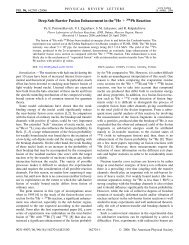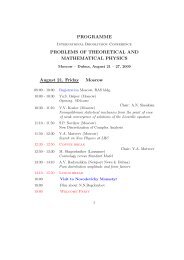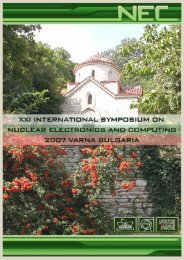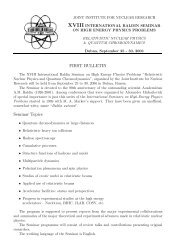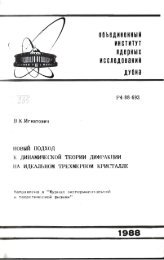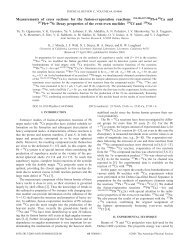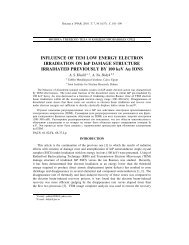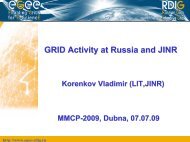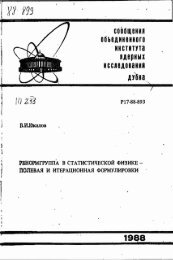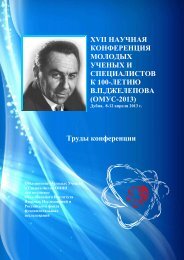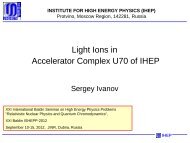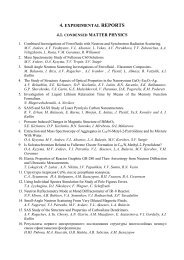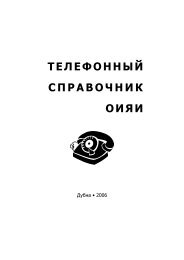Hubbard_John - Bogoliubov Laboratory of Theoretical Physics - JINR
Hubbard_John - Bogoliubov Laboratory of Theoretical Physics - JINR
Hubbard_John - Bogoliubov Laboratory of Theoretical Physics - JINR
- No tags were found...
Create successful ePaper yourself
Turn your PDF publications into a flip-book with our unique Google optimized e-Paper software.
JOHN HUBBARD: THE MAN BEHIND THE MODEL.Those who knew <strong>John</strong> <strong>Hubbard</strong> describe him as a very shy man – to the point thatothers, who did not know him so well, may have perceived him as somewhat alo<strong>of</strong>.Born on 27 October 1931, <strong>Hubbard</strong> was educated first at Hampton Grammar schooland then at Imperial College, London, where he obtained his PhD in 1958 underStanley Raimes. Unusually for his time and social context, he lived with his parents inTeddington throughout his university education. At the end <strong>of</strong> his PhD, <strong>Hubbard</strong> wasrecruited to the Atomic Energy Research Establishment in Harwell, Oxfordshire, byBrian Flowers, who was then heading the theory division. An anecdote from this period<strong>of</strong> <strong>Hubbard</strong>’s career illustrates his retiring personality.While at Imperial, <strong>Hubbard</strong> had dealt with the project assigned to him for his PhDfairly quickly, and had then looked for a more challenging problem. At the time,quantum-field-theory methods, particularly Feynman diagrams, were being applied toproblems in many-body theory. However, it was difficult to bring the same methods tobear on the many-electron problem – relevant to solid-state systems – because theCoulomb interaction between electrons made quantities like the total energy diverge.<strong>Hubbard</strong> realized that these divergences could be controlled: the trick was to sum upan infinite series <strong>of</strong> a particular class <strong>of</strong> Feynman diagrams.When <strong>Hubbard</strong> arrived in Harwell, he mentioned this to Flowers, who wanted to seethe paper. Alas, there was no paper, <strong>Hubbard</strong> explained, because when he was about towrite it up he saw an article by other researchers who had introduced a differentmethod to solve the same problem. <strong>Hubbard</strong> had found their method physicallyappealing, checked privately that their results coincided with his, and concluded therewas no need for an additional publication on the topic. Flowers then issued an explicitorder that <strong>Hubbard</strong> should publish his groundbreaking work.<strong>Hubbard</strong>’s most famous papers are the series he wrote on his eponymous model,starting in 1963. He was not the only one working on the strong-correlations problem:some months earlier, Takeo Izuyama, working at Nagoya University, and Duk-Joo Kimand Ryogo Kubo, at the University <strong>of</strong> Tokyo, both in Japan, had argued that a properdescription <strong>of</strong> correlations in metals with strong electron–electron interactions couldexplain the observed spin-wave spectrum. Martin Gutzwiller, who was then working atIBM’s research laboratories in Zurich, had also produced essentially the same model.Yet it was <strong>Hubbard</strong>’s calculations that showed that the model that now bears his namecould in fact describe both the metallic and insulating behaviour as two extremes <strong>of</strong> thesame thing. His application <strong>of</strong> a Green’s function technique to the model was atemplate for many other works in condensed-matter theory, and his papers from thattime contain many crucial insights, such as the existence <strong>of</strong> so-called <strong>Hubbard</strong> bandsthat are a main feature <strong>of</strong> our current understanding <strong>of</strong> Mott insulators.Eventually, <strong>Hubbard</strong> became the leader <strong>of</strong> the solid-state theory group at Harwell, andWalter Marshall succeeded Flowers as head <strong>of</strong> the theory division. Unlike the shy<strong>Hubbard</strong>, Marshall, who was also an excellent theorist, was very proactive in huntingfor personnel and for funding. This was a blessing in disguise for <strong>Hubbard</strong>, asMarshall ignored <strong>Hubbard</strong>’s reticence completely and kept “parachuting” postdocsinto his group.<strong>Hubbard</strong> left the UK for the US in 1976, following Marshall's promotion to director <strong>of</strong>the Atomic Energy Research Establishment and a subsequent major reform <strong>of</strong> its



